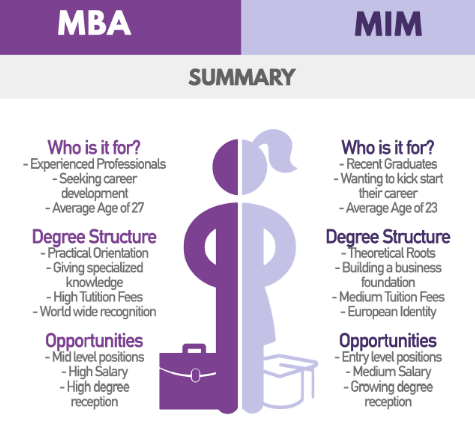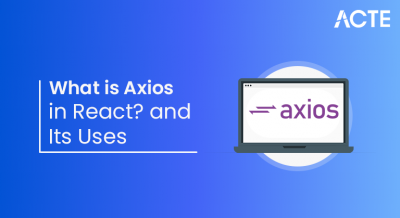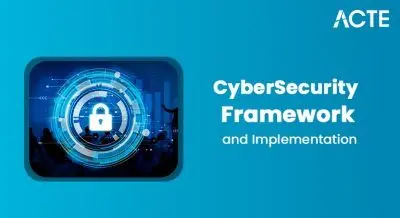
- What is a MiM?
- What is an MBA?
- Key Differences
- Curriculum Comparison
- Cost and Duration Comparison
- Eligibility Criteria
- Career Opportunities
- Conclusion
What is a MiM?
A Master in Management (MiM) is a postgraduate degree designed for individuals at the early stages of their professional journey, typically with little to no full-time work experience. The MiM program is ideal for recent graduates who wish to develop a strong foundation in business and management before entering the workforce or progressing to more senior roles in the future. Generally lasting one to two years, the MiM curriculum provides comprehensive training in key management disciplines such as accounting, marketing, operations, finance, and human resources. It emphasizes both theoretical knowledge and practical application, helping students understand how businesses operate and how strategic decisions are made in real-world settings. One of the primary strengths of the MiM is its structured and well-rounded approach to management education. While the program focuses on core subjects, many universities also offer opportunities for students to specialize in specific fields such as international business, entrepreneurship, or supply chain management. Additionally, programs often include internships, group projects, case studies, and sometimes international exchanges to give students valuable hands-on experience and global exposure. MiM students are typically younger than MBA students, often entering the program directly after completing an undergraduate degree. As a result, the classroom environment is highly dynamic and collaborative, allowing students to build strong interpersonal and teamwork skills. Overall, a Master in Management equips students with essential business knowledge and leadership capabilities, making it a valuable stepping stone for launching successful careers across a wide range of industries and functions.
What is an MBA?
An MBA, or Master of Business Administration, is one of the most recognized and sought-after postgraduate degrees in the field of business. Unlike the Master in Management (MiM), which targets early-career individuals, the MBA is designed for professionals who have accumulated significant work experience, typically around three to five years or more. This program focuses on advanced business theories, leadership development, and strategic decision-making, making it well-suited for those who aim to advance into senior management or executive positions within their organizations. The MBA curriculum is comprehensive and flexible, allowing students to choose from a wide range of specializations, including finance, marketing, entrepreneurship, operations, and human resources. This flexibility enables students to tailor their education to align with their career goals and interests. Many MBA programs also offer Executive MBA (EMBA) options, which cater to experienced professionals with ten or more years of work experience. These programs are designed to accommodate the busy schedules of working executives and often emphasize leadership skills and strategic management at a higher level. The core objective of the MBA is to provide students with the knowledge, skills, and confidence necessary to lead organizations effectively, whether by climbing the corporate ladder or launching their own business ventures.

Additionally, MBA programs frequently include practical components such as case studies, group projects, internships, and networking opportunities with industry leaders. This hands-on approach equips graduates with the real-world experience needed to navigate complex business challenges. Overall, an MBA serves as a powerful tool for career advancement, opening doors to leadership roles and entrepreneurial success.
Key Differences
- Target Audience – MiM: The Master in Management (MiM) is designed mainly for recent graduates or individuals with little to no professional work experience, typically under three years.
- Target Audience – MBA: The Master of Business Administration (MBA) targets mid-career professionals who usually have several years of work experience and seek to advance or shift their careers.
- Program Duration – MiM: MiM programs generally last between one to two years, offering a quicker pathway into management roles.
- Program Duration – MBA: MBA programs usually span two years, though Executive MBA (EMBA) options are often shorter or designed with flexible schedules for working professionals.
- Career Focus – MiM: MiM emphasizes foundational management and business skills, preparing graduates for entry-level or junior management roles across industries.
- Career Focus – MBA: MBA curricula are tailored toward leadership development, strategic thinking, and specialized managerial competencies, aligning with goals for executive or senior management positions.
- Outcomes and Expectations: While MiM graduates typically enter the workforce as managers or analysts, MBA graduates often pursue higher-level responsibilities, career shifts, or entrepreneurial ventures, leveraging their experience and network.
- Curriculum Focus: MiM programs introduce students to core business concepts in a structured and theoretical way, while MBA programs emphasize applying these concepts in real-world, strategic scenarios.
- Student Profile and Learning Needs: MiM is tailored for recent graduates with little to no work experience, focusing on building foundational knowledge, whereas MBA targets professionals with several years of experience, enhancing leadership and decision-making abilities.
- MiM Core Subjects: MiM curricula typically include financial accounting, marketing management, operations management, leadership development, business ethics, and organizational behavior, offering broad exposure to business fundamentals.
- Practical Exposure in MiM: While theory-driven, MiM programs also incorporate internships, case studies, or international exchange modules to provide early practical experience, though with limited strategic focus.
- MBA Core Subjects: MBA programs offer advanced subjects such as strategic management, entrepreneurship, corporate governance, advanced financial management, business law, and leadership and change management, tailored for real-world executive challenges.
- Specialization and Flexibility: MBA students can often select from a wide range of electives or focus areas like consulting, finance, marketing, or HR, providing flexibility to align learning with career goals MiM programs usually have a more fixed structure.
- Leadership and Networking Opportunities: MBA programs emphasize leadership training and offer extensive networking through workshops, alumni events, and industry interactions, preparing students for higher managerial or entrepreneurial roles.
- Educational Qualification: Both MiM and MBA programs require a bachelor’s degree from an accredited institution: this is the foundational academic requirement for admission into either program.
- Work Experience: MiM programs are suited for recent graduates with little to no work experience, typically less than three years: in contrast, MBA programs generally require candidates to have between three to five years of professional experience.
- Academic Performance: MiM applicants are expected to have strong academic records during their undergraduate studies academic excellence is especially important as these candidates may not yet have significant work experience to strengthen their profile.
- Standardized Test Scores: Some MiM programs require GMAT or GRE scores, although many especially in Europe are moving away from this requirement: MBA programs more commonly expect GMAT or GRE scores, although waivers are sometimes available for experienced professionals.
- Leadership and Achievements: MiM applicants are not necessarily required to show leadership experience but may benefit from strong extracurricular involvement: MBA applicants are often expected to demonstrate leadership potential through professional accomplishments or significant roles in organizations.
- Language Proficiency: For both programs, non-native English speakers must typically provide proof of English language proficiency through exams such as TOEFL or IELTS: this ensures readiness for academic and professional communication in an international environment.
- Program Expectations: MiM programs focus on candidates with academic promise and a desire to enter business careers MBA programs seek individuals ready to transition into higher-level leadership or specialized roles based on experience and strategic thinking.
Curriculum Comparison

Cost and Duration Comparison
When comparing the cost and duration of Master in Management (MiM) and Master of Business Administration (MBA) programs, several important differences emerge that can influence a candidate’s decision. Generally, MiM programs are shorter and less expensive than MBA programs. The typical MiM lasts between one and two years, making it a more time-efficient option for recent graduates or early-career professionals seeking foundational management education. In contrast, MBA programs usually span two years, though some accelerated or part-time options exist, and Executive MBA programs can vary in length depending on their format. Cost is a significant factor distinguishing the two degrees. MiM programs tend to have lower tuition fees, often ranging from $15,000 to $40,000 depending on the institution and country. This more affordable pricing reflects the shorter duration and focus on entry-level management training. MBA programs, on the other hand, can be considerably more expensive, with tuition fees frequently exceeding $60,000 and in many top business schools reaching upwards of $100,000. The higher cost of MBA programs is often justified by the advanced curriculum, extensive networking opportunities, career services, and the increased earning potential for graduates. Additionally, MBA students typically have several years of work experience and may be able to offset costs through employer sponsorship or higher post-graduation salaries. MiM students, being earlier in their careers, might have fewer financial resources but benefit from lower overall program costs. Ultimately, the choice between MiM and MBA will depend on an individual’s career stage, budget, and long-term goals, with cost and duration playing key roles in the decision-making process.
Eligibility Criteria
Career Opportunities
Master in Management (MiM) graduates typically begin their careers in entry-level or junior management positions across a variety of industries. Common roles for MiM alumni include management consultant, business analyst, marketing coordinator, financial analyst, and operations manager. These positions allow graduates to apply the foundational business knowledge and management skills they have acquired during their studies. MiM graduates often find employment in large multinational corporations, consulting firms, or dynamic startup environments. Because MiM programs focus on broad-based business education, graduates have the flexibility to explore different industries and functional areas. As they gain work experience, they have the opportunity to advance quickly, taking on greater responsibilities and moving up the corporate ladder. In contrast, MBA graduates generally enter the workforce at a more advanced level, often moving into senior management roles or executive positions. Career paths for MBA holders include senior manager or director roles in functions such as marketing, finance, and operations. Many MBA graduates also pursue executive-level positions such as CEO, CFO, or COO. Others use their education and network to start their own businesses or become entrepreneurs. Management consulting and investment banking are also popular career options for MBA graduates. One of the key advantages of an MBA program is the extensive networking opportunities it offers. Students frequently interact with business leaders and industry professionals, which can open doors to high-level roles and accelerate career growth. Overall, both MiM and MBA programs provide valuable career opportunities, but the choice depends on an individual’s experience level and long-term professional goals.
Conclusion
Both Master in Management (MiM) and Master of Business Administration (MBA) programs offer valuable education in business and management, but choosing the right program depends largely on an individual’s professional experience, career aspirations, and financial considerations. MiM programs are specifically designed for recent graduates or early-career professionals with little to no work experience. These programs focus on building foundational management knowledge, leadership skills, and a broad understanding of business functions. For those just starting their careers, MiM offers a structured and comprehensive way to develop essential business competencies and prepare for entry-level or junior management roles. The shorter duration and generally lower cost of MiM programs also make them an attractive option for young professionals looking to quickly gain credentials and enter the workforce. On the other hand, MBA programs are geared towards professionals who already have several years of work experience and want to advance into senior management or executive positions. MBA curricula emphasize strategic thinking, advanced leadership, and specialized business knowledge. These programs often provide opportunities for networking with industry leaders and gaining real-world experience through case studies, internships, and group projects. MBAs are ideal for those seeking to elevate their careers, switch industries, or launch entrepreneurial ventures. However, they tend to be longer and more expensive than MiM programs, which is an important factor to consider. Ultimately, the decision between MiM and MBA should be based on one’s current career stage, professional goals, and financial situation. Both degrees open doors to rewarding careers in business, but choosing the right path ensures that education aligns with personal and professional development needs.



